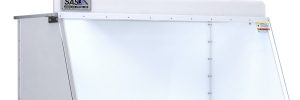3M Super 77 Multipurpose Adhesive Spray is used regularly in a variety of creative industries, including graphic design, advertising, model-making and architectural firms, product packaging companies, printing shops, and more. Because this product is so useful and may be used practically everyday in some businesses, the health effects associated with it are often overlooked. In reality, your… Learn More
Category: Chemicals & Solvents
Content centered around Chemical and Solvent applications and what Sentry Air offers to mitigate common fume, particulate, and spills found in these applications.
Testimonial: Ductless Spray Paint Booth for Paints & Solvents
Our Ductless Spray Paint Hoods are receiving raving reviews about their performance and safety features. Here are two testimonials from different customers about their Sentry Air experience. Spray Painting Custom Radio Controlled Aircraft Canopies I purchased my Sentry Air Systems spray hood to control the fumes and particulates when spray painting custom radio-controlled aircraft canopies…. Learn More
Collodion Adhesive: Possible Health Effects & Fume Extraction Recommendations

Collodion, a combination of nitrocellulose, ethyl ether, and ethanol, is a substance that is used for attaching electrodes to the head during EEG’s (Electroencephalography). EEG’s are performed for a variety of medical reasons and are a primary research and diagnostic tool regarding electrical activity in the brain. Electrodes must securely be attached to the scalp… Learn More
Reducing Exposure to Hazardous Organic Solvents
When working with organic solvents, laboratory professionals should utilize engineering controls such as fume hoods and fume extractors to help protect themselves from hazardous exposure. Depending on the solvent, health side effects from exposure can result in life-long harm or conditions. According to the Occupational Safety & Health Administration (OSHA), the “health hazards associated with… Learn More
Sentry Air Systems Case Study: Isopropyl Alcohol Fume Control

Below is an Industrial Hygiene Report conducted by Robert F. Adams from RF Adams & Associates, Inc. This report details test procedures and results of Sentry Air Systems Equipment and Isopropyl Alcohol. Introduction Sentry Air Systems, Inc. manufactures equipment designed to capture organic solvent vapors and/or other air contaminants and, after removal, return the cleaned… Learn More
Sentry Air Systems Case Study: MEK Fume Removal
Methyl Ethyl Ketone Fumes: Methyl Ethyl Ketone, also known as MEK and butanone, is one of the most prevalent ketone compounds and is used in a wide variety of applications. It is primarily produced industrially on a large scale from 2-butanol. MEK is a popular solvent and dissolves many materials. It is frequently used to… Learn More
Hazards of Epoxy Fumes
What is Epoxy? Epoxy, also known as polyepoxide or an epoxy resin system, is the combination of epoxy resin and a curing agent (also called a catalyst or hardener). Common applications include bonding adhesive, paints and coatings, primers and sealers, patching and resurfacing, flooring, chemical containment, wood repairs, electrical applications, composite materials, marine applications, aerospace… Learn More
Sentry Air Systems Case Study: Acetone Fume Removal
Acetone Fumes: Acetone, also known as propanone and dimethyl ketone, is the simplest example of ketone compounds and is also a very important building block in organic chemistry. It is produced and disposed of naturally in the body as a result of normal metabolic processes. The majority of acetone is produced from propylene in a… Learn More
Ductless Fume Hood Case Study: Toluene Vapors
Toluene Fumes: Toluene, also known as methyl benzene, is an aromatic hydrocarbon that occurs naturally at low levels in crude oil and which is also produced as a byproduct in fuel production. Its electrophilic properties make it a useful feedstock in industrial processes such as the production of TNT and polyurethanes. It is also used… Learn More
Ductless Fume Hood Case Study: Xylene Fumes
Xylene Fumes: Xylene is a name given to any one of three aromatic hydrocarbon isomers produced from crude oil. Each of the isomers is similar in its properties. There are many applications in which the use of these xylene isomers is necessary including uses such as a solvent in the leather, rubber, and printing industries…. Learn More

 Made in the USA
Made in the USA